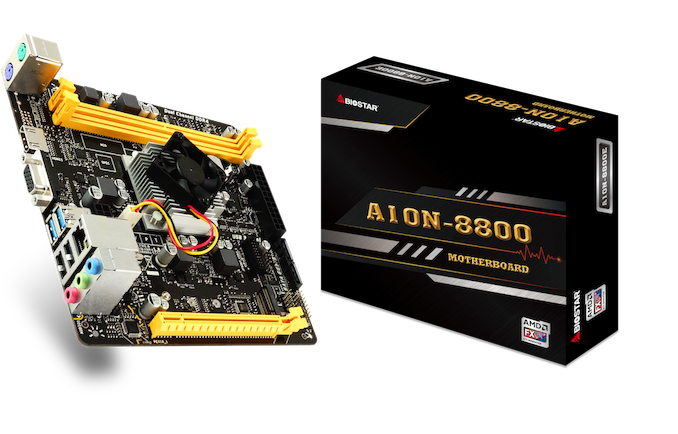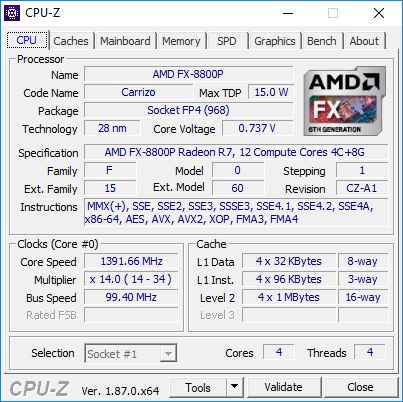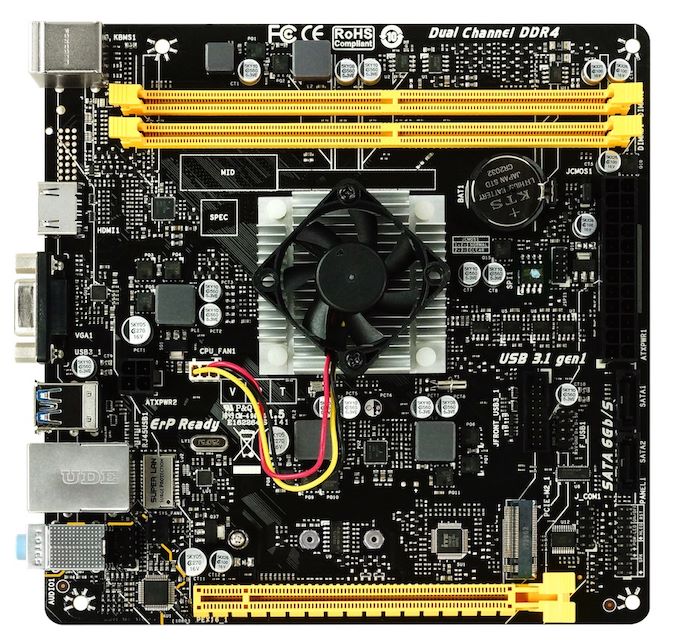The Biostar A10N-8800E Motherboard Review: Carrizo in 2019?!
by Dr. Ian Cutress & Gavin Bonshor on August 14, 2019 8:00 AM EST- Posted in
- Motherboards
- CPUs
- AMD
- Biostar
- Mini ITX
- HTPC
- Carrizo
- A10N-8800E
- FX-8800P
- Athlon 200GE

The Biostar A10N-8800 motherboard is a mini-ITX SoC option with an integrated AMD FX-8800P processor. Also featured is support for up to 32 GB of DDR4-2133 memory, a single full-length PCIe 3.0 x16 slot, and a Realtek RTL8111H Gigabit Ethernet port. The AMD FX-8800P is traditionally a mobile SKU with a TDP of 35 W and Biostar integrates into a small form factor package for desktop users with four CPU cores and eight Radeon R7 graphics cores.
We asked for a review sample of this motherboard for the simple reason that we did not expect to see a brand new AMD Carrizo based design hit the market in 2019. Carrizo is from AMD's older family of processors, pre-Zen, and Biostar believes there is a new market out there for mobile-class gaming machines. The FX-8800E processor being used here sits at the top of Biostar's stack of integrated CPU offerings, which makes it even more bizarre that there are lower powered chips available for this sort of thing. We still wanted to give it our traditional motherboard rundown.
Biostar A10N-8800E Overview
The Biostar A10N-8800E mini-ITX motherboard comes pre-installed with AMD’s FX-8800P Carrizo based SoC processor which utilizes four cores, four threads, with a maximum core clock speed of up to 3.4 GHz. The AMD FX-8800P is the top tier processor from the 6th generation Carrizo family with '12 compute cores' according to the marketing materials: four for the CPU and eight for the Radeon R7 integrated graphics module. With a lot of SoC offerings, low power consumption is a huge factor and the SoC is rated for a 15 W TDP, with OEM configuability up to 35W.
While not benefiting from the kind of grunt power that a processor containing AMD Zen architecture offers, the FX-8800P represents a more modest option and has built-in hardware HEVC and H.265 decoding abilities. That being said, the FX-8800P is using AMD's outdated Excavator architecture, which isn't detrimental as such, but it slots it into a lower positioned tier of products.
Looking at the Biostar A10N-8800E as we do with all motherboards, the board has an all-black PCB with a set of yellow contrasting slots; Biostar could have even gone with the Bumblebee to generate some BUZZ. In the center of the board is the very basic and low profile integrated CPU heatsink, with a basic 2+1 phase power delivery (two for the CPU and one for the iGPU/SoC). Located at the top of the board and mounted horizontally, is two RAM slots with support for DDR4-2133 and up to a maximum capacity of 32 GB. At the bottom is a single full-length PCIe 3.0 x16 slot with a single M.2 slot situated directly above it; a total of two SATA connectors makes up the rest of the onboard storage capabilities.
The rear panel of the Biostar A10N-8800E represents simplicity connectors with just four USB connectors on the rear panel, all Type-A with two USB 3.1 G1 and two USB 2.0. Legacy users will appreciate a separate PS/2 keyboard and mouse port, with an HDMI and D-sub pairing of video outputs. A basic Realtek ALC887 HD audio codec takes care of the onboard audio, while a Realtek RTL8111H Gigabit NIC powers the single Ethernet port.
When it comes to the system performance of the Biostar A10N-8800E, there are certainly some positive points to go away with when benchmarked on our test bed. Booting into Windows 10 64 bit from our Crucial MX300 1 TB test bed SSD, we achieved a very respectable result of 18.6 seconds at default. When stripped of the networking and audio controllers, we managed to shave around an extra second off that time. Power consumption as expected is also favorable with a maximum peak load in our stress testing of just 53.8 W. This was tested without a discrete graphics card as the main focus is on the capability of the integrated AMD FX-8800P processor.
Marketed as an 'Edge Computing' solution, the Biostar A10N-8800E uses a mini-ITX PCB and a mobile processor. With a TDP of just 15 W, it opines to be a low powered desktop system or even a microserver. The motherboard itself has plenty to shout about with a Realtek pairing of networking and onboard solutions which aren't high-end but are more than up to the task, and with integrated Radeon R7 graphics with HDCP support, it could be the perfect foundation for a solid small form factored HTPC.













73 Comments
View All Comments
DanNeely - Wednesday, August 14, 2019 - link
page 4: "Comparing $88 vs $112 is an important point here - if you are tied for cash, you might go with the $88 option. But what performance uplift do you get from an additional $14?" That's $24 not 414.sing_electric - Wednesday, August 14, 2019 - link
And it continues through the next page. It means you're looking at 27% more price, and that's roughly fair given the performance differences seen. Both could be good buys depending on where you want to spend your cash on the build. (I kind of love planning REALLY cheap builds since the low budget makes you really work at trade offs - the $24 difference is a 120GB SSD or 4GB stick of RAM, for example. It's like a haiku, where you really need to strip things down to what matters.)The_Assimilator - Wednesday, August 14, 2019 - link
"...Biostar believes there is a new market out there for mobile-class gaming machines"There is, but not for gaming machines that suck.
JWade - Wednesday, August 14, 2019 - link
I think it would make for a good little multi media pc, its itx with an m.2 slot. can have a good little media player for under $200. the 200GE is with a micro atx board and is quite a bit bigger. when ever Newegg gets around to selling it, I will definitely buy one for the size its great I thinkDug - Wednesday, August 14, 2019 - link
"if you are tied for cash, you might go with the $88 option"If you are that tied for cash you might consider buying food instead of buying new computer parts.
sing_electric - Wednesday, August 14, 2019 - link
Fair, but there's always marginal cases where you just want something under a certain price. Say you're outfitting a community center or something with computers, the $24 you save might be significant when you look at the # of units you need. There's always ways to spend more money for better performance, but for a lot of applications, the speed difference might not be noticeable.Plus, within any budget, there's smart and dumb ways to spend your money - the price difference between these is basically enough to get you a 120GB SSD at today's prices, for example, or go from 1 4GB stick of RAM to 2.
Tams80 - Thursday, August 15, 2019 - link
You can be tied for cash within a budget. If you have a budget for a computer, you almost certainly have budgets for food, utilities, transport, etc. So by not buying a cheap computer, you end up with possibly a few nicer meals but no computer.digitalgriffin - Wednesday, August 14, 2019 - link
Do a search in article for (insert model here) for the Audio Driver.Also listing the HDMI version would be critical to those looking to use this as a Media Server. One would hope it's HDMI 2.0 at least.
sandtitz - Wednesday, August 14, 2019 - link
As stated in the article:Realtek ALC887
HDMI 1.4
Flunk - Wednesday, August 14, 2019 - link
Carrizo doesn't support HDMI 2, you need to go newer.